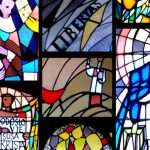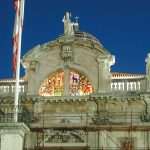On April 6 in 1667, a massive earthquake hit Dubrovnik and turned the most beautiful town of the Adriatic into a pile of stones. The fire that followed immediately after destroyed what was left. Nearly all the churches were destroyed or heavily damaged. Only the Church of St Blaise, Dubrovnik’s patron saint, survived the earthquake. However, on May 24 in 1706, the beautiful medieval church built in Gothic style was completely destroyed by a fire. All the works of art disappeared; the only piece that was left in the ashes was a small gilded statue of St Blaise. The new church was designed by the Venetian architect Marino Gropelli and built in Baroque style; its monumental facade is the most beautiful decoration of the Main Square in Dubrovnik Old Town.
In 1972, the city of Dubrovnik celebrated an unusual jubilee, a thousand years of St Blaise’s protection. On that occasion the city decorated the windows of its most beautiful church by putting in the stained glass ones. The task to merge the stained glass windows into the richly decorated Baroque architecture and thematically fill in the large panes was given to Ivo Dulčić, a famous painter from the city. The painter’s style had many elements of Baroque art, rhythm in colour and line, liveliness, restlessness and uniqueness, which enabled him to incorporate harmoniously the stained glass windows into the Baroque architecture.
Dulčić also found the theme very easily in his well-known faith and famed love for his hometown. Beginning with the facade, the entrance to the church, he placed the evangelists in the arched panes and the apostles that were founders of our faith, Saints Peter and Paul, and Saints Cyril and Methodius, to the left and right. After establishing firmly his faith through the apostles he continued to the faith of the city strongly expressed in the annual feasts of its patron saint and protector, St. Blaise. One pane illustrates the opening ceremony of the feast in times of Dubrovnik Republic and the next the spectacular annual procession taking place during the feast in all its might and glory. The last two panes depict the famous reliquaries of the Saint in golden hues on purple background and the city of Dubrovnik with the ode to freedom, the motif of many works of art originating in the city, gloriously bathed in the Mediterranean sun.
Thematically, the motifs show Dulčić as the fervent believer, who considers the Church as the greatest value, especially accentuating the love for St. Blaise and the city of Dubrovnik. The same person of great faith and love is famous for many other remarkable works of art. His deep faith made him the most fruitful painter of religious themes in modern Croatian art.





